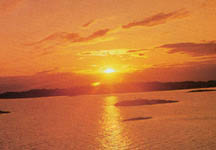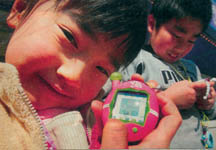
Sunlight round the clock
It is midsummer now in the Northern Hemisphere, in the countries
North of the Tropic of Cancer, that is in Japan, China, Korea, Siberia,
in Asia, in the whole of Europe, in North America and Canada.
However, the actual Midsummer Day fell on June 21. On this day, the
sun seemed to appear directly overhead the Tropic of Cancer, which is
2,600 km north of the equator.

Do you remember reading about the Vernal Equinox - March 21 - in the
March 19 issue of the Junior Observer? There you would have read that on
March 21, the sun appears to be directly overhead the equator, and the
verticle rays of the sun strike the Earth perpendicularly (at a 90
degree angle). This day, March 21, marks the beginning of Spring in the
Northern Hemisphere.
You would have learnt in your Social Studies or Geography class, that
the Earth is divided into two halves or hemispheres by an imaginary line
that runs round the middle of the Earth, known as the equator.
After March 21, the sun appears to move northwards. As seen from the
Earth's equator, the sun is rising and setting at a point north of the
equator. Each day the sun's rising and setting point has moved further
north.
In the account of the Vernal Equinox (See March 19 issue), you would
have read that the sun passes directly over Sri Lanka from about April 5
to 9. Sri Lanka lies between 5.55 degrees and 9.51 degrees north of the
equator. This northward progression continues until the Tropic of Cancer
is reached on June 21. The sun has moved 2,600 Km north since March 21.
In geographical terms, it is 23.5 degrees north of the equator. The sun
doesn't move any further.
June 21 is the Summer Solstice. 'Sol' in Latin is sun, and 'Sistere'
is stand still. The ancients believed that the sun paused at this point,
on this day, before starting to move South.
As the sun moved North, little by little, each day since March 21,
the days got longer and the nights shorter. Now, there are more hours of
daylight and the hours of darkness are less. This increase in daylight
is very marked as the distance from the equator increases, there is
daylight round the clock for weeks, within the Arctic Circle, which is
66.5 degrees north of the equator.
One third of Norway is within the Arctic Circle. So Norway has 'White
nights' from mid-May to the end of July during which time the sun
doesn't set. So Norway is called the 'Land of the Midnight Sun'.
It is not only in Norway that the sun doesn't set for days in summer.
It is the same in all countries in the same latitude. Sweden, Finland,
Iceland, Greenland and Alaska are having sunlight round the clock now or
a long twilight, before the sun rises again. This is what a Swede has
written about his own country. "On midsummer eve, when sunshine lasts
round the clock in the far North, and only fades into a blue twilight
for a few hours in the South, Sweden is at its most beautiful".
South Sweden has a summer of more than four months, and so has
Norway.
Parts of Greenland, which are closer to the North Pole, than Norway
is in total darkness for four months, from about October 21. The sun
never appears above the horizon until February 21, and for two months,
the sun rises earlier and sets later each day. Then, on or about April
21, the sun rises, but doesn't set. For the next four months, it circles
the sky once every 24 hours.
Can you imagine living in continuous daylight for four months? No
nights, only days until about August 21, when the sun sets. Then
onwards, increasing periods of daylight alternate with increasing
periods of twilight for two months, until the sun sets again on October
21 and four months of darkness begin.
In countries not so far north like Scotland, England, Denmark, China
and Japan, at this time of the year, there is daylight even at 10 p.m.
After weeks and months of darkness, when there was no sunlight at
all, or only for a brief half an hour or one hour, the long hours of
daylight is a bonus, a gift from Mother Nature.
Midsummer Day is a holiday in Sweden and Finland, and in Iceland a
movable holiday in late June. The Summer Solstice is a day for
celebrations. Each country has its own celebration.
This is about the celebration in Sweden: "The Mid Summer Eve
celebration is an ancient tradition with its roots in prehistoric Summer
Solstice festivals. The leaf-clad maypole - perhaps our most familiar
national symbol - is a custom going back to ancient Rome, medieval
Germany and France. This fertility festival is celebrated with a unique
passion in Sweden."
Sumana Saparamadu.
Virtual pet toy is back
Ten years after it first became a global fad, Tamagotchi has found
homes again with a new generation of young children.
|

The latest Tamagotchi version comes with communications
capabilities so that owners of the egg-shaped digital pet gadgets
can meet and play games through an infrared sensor.
|
Sales of the latest version of the small egg-shaped digital pets,
which require virtual feeding, cleaning and play several times a day,
topped 20 million units worldwide, two years after its launch. Priced at
about US$25, each gadget comes with communications capabilities, so that
Tamagotchi owners can meet and play games through an infrared sensor.
Japanese toymaker Bandai is hoping a richer world of characters and
cautious marketing will give the latest version staying power, unlike
the original, which disappeared suddenly after a brief run in the
mid-1990s.
"We've always wanted to try to revive the Tamagotchi because the
craze ended so fast," said Takeiuchi Hongo, Bandai's 51-year-old chief
Tamagotchi officer, admitting that the company was caught off guard when
the toy became a phenomenon in the 1990s, particularly among schoolgirls
and young women.
What started in 1996 as a simple idea for a portable virtual pet
turned into a cultural icon of the digital age.
However, countries like China and the Philippines condemned the toy
as anti-social and schools around the world banned them.
Still, Bandai could not keep up with demand. By the time it was able
to do so in the late 1990s, the boom was over.
Reuters |












